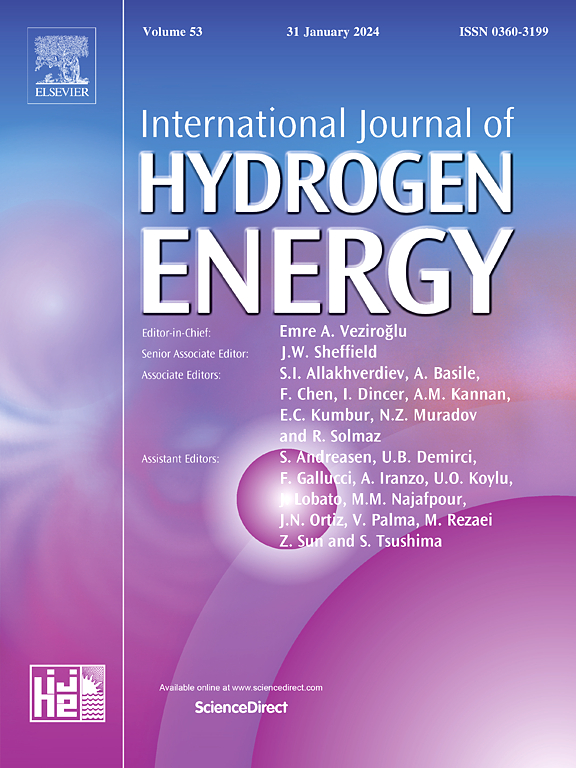非催化纳秒脉冲等离子体反应器中甲烷的可调干重整
IF 8.1
2区 工程技术
Q1 CHEMISTRY, PHYSICAL
引用次数: 0
摘要
纳秒脉冲放电(NPD)等离子体可以有效地促进甲烷(DRM)的干重整,通过可调节振幅和频率的尖锐能量脉冲将甲烷(CH4)和二氧化碳(CO2)的原料混合物(典型的沼气流)转化为合成气和C2物种,以优化能量输送。连续脉冲和分组脉冲(爆发)都是通过控制放电中的耗散功率来驱动反应物的转换。由于CH4偶联反应和CO2解离与DRM反应相辅相成,因此出口合成气组成可以通过原料气比线性调节。随着比能输入(SEI)的增加,CH4和CO2的转化率呈饱和趋势,最大值分别为83%和75%。然而,能量转换效率(ECE)与SEI呈非单调趋势,这可能是由于高脉冲频率下的记忆效应,这促进了低能量下的气体击穿。后一种条件促进47%的排放能转化为化学能,而较高的反应物的转化以较低的效率(即27%)实现。NPD等离子体DRM工艺在风能和太阳能驱动下产生氢气,二氧化碳排放量为负(即分别为- 9 kgCO2 kgH2 - 1和- 7 kgCO2 kgH2 - 1),而最先进的蒸汽甲烷重整排放约为10 kgCO2 kgH2 - 1。本文章由计算机程序翻译,如有差异,请以英文原文为准。
Tunable dry reforming of methane in a non-catalytic nanosecond-pulsed plasma reactor
Nanosecond-pulsed-discharge (NPD) plasma can effectively promote dry reforming of methane (DRM) to convert feedstock mixtures of methane (CH4) and carbon dioxide (CO2), typical of biogas streams, into syngas and C2 species through sharp energy pulses that can be regulated in amplitude and frequency to optimize energy delivery. Both continuous pulsing and grouped pulses (bursts) drive reactants' conversion by controlling the dissipated power in the discharge. The syngas composition at the outlet can be linearly tuned via the feed gas ratio, as CH4 coupling reactions and CO2 dissociation complement the DRM reaction, maintaining the correlation. CH4 and CO2 conversions follow a saturation trend with specific energy input (SEI), with maximum values of 83 % and 75 %, respectively. Nonetheless, the energy conversion efficiency (ECE) shows a non-monotonic trend with SEI, likely due to memory effects at high pulse frequencies, which promote gas breakdown at low energy. The latter conditions promote 47 % conversion of discharge energy into chemical energy, whereas higher reactants’ conversions are attained at a lower efficiency (i.e., 27 %). The NPD plasma DRM process produces H2 with negative CO2 emissions when powered by wind and solar energy (i.e., −9 kgCO2 kgH2−1 and −7 kgCO2 kgH2−1, respectively), in contrast to the state-of-the-art steam methane reforming, which emits about 10 kgCO2 kgH2−1.
求助全文
通过发布文献求助,成功后即可免费获取论文全文。
去求助
来源期刊

International Journal of Hydrogen Energy
工程技术-环境科学
CiteScore
13.50
自引率
25.00%
发文量
3502
审稿时长
60 days
期刊介绍:
The objective of the International Journal of Hydrogen Energy is to facilitate the exchange of new ideas, technological advancements, and research findings in the field of Hydrogen Energy among scientists and engineers worldwide. This journal showcases original research, both analytical and experimental, covering various aspects of Hydrogen Energy. These include production, storage, transmission, utilization, enabling technologies, environmental impact, economic considerations, and global perspectives on hydrogen and its carriers such as NH3, CH4, alcohols, etc.
The utilization aspect encompasses various methods such as thermochemical (combustion), photochemical, electrochemical (fuel cells), and nuclear conversion of hydrogen, hydrogen isotopes, and hydrogen carriers into thermal, mechanical, and electrical energies. The applications of these energies can be found in transportation (including aerospace), industrial, commercial, and residential sectors.
 求助内容:
求助内容: 应助结果提醒方式:
应助结果提醒方式:


